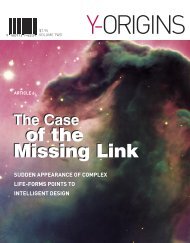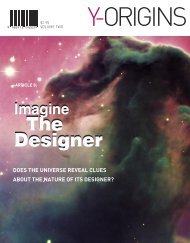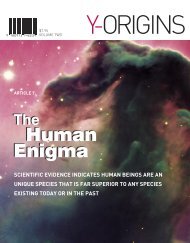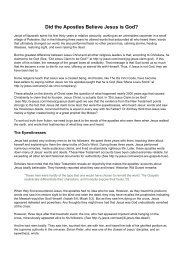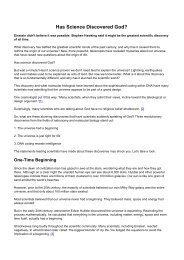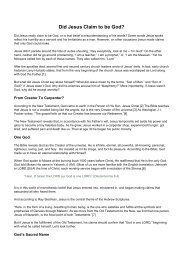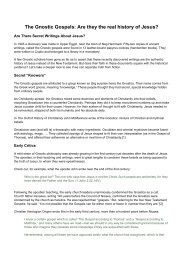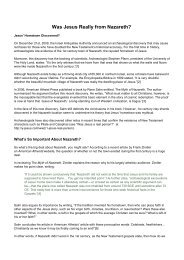1852
Create successful ePaper yourself
Turn your PDF publications into a flip-book with our unique Google optimized e-Paper software.
Was There a Da Vinci Conspiracy?<br />
Mona Lisa’s Smirk:<br />
The Da Vinci Code is not to be ignored as a fictional plot. Its premise, that Jesus Christ has been reinvented for<br />
political purposes, attacks the very foundation of Christianity. Its author, Dan Brown, has stated on national TV<br />
that, even though the plot is fictional, he believes its account of Jesus’ identity is true. So what is the truth? Let’s<br />
take a look.<br />
Did Jesus have a secret marriage with Mary Magdalene?<br />
Was Jesus’ divinity invented by Constantine and the church?<br />
Were the original records of Jesus destroyed?<br />
Do recently discovered manuscripts tell the truth about Jesus?<br />
Has a gigantic conspiracy resulted in the reinvention of Jesus? According to the book and movie, The Da Vinci<br />
Code, that is exactly what happened. Several of the book’s assertions regarding Jesus smack of conspiracy. For<br />
example, the book states:<br />
“Nobody is saying Christ was a fraud, or denying that He walked the earth and inspired millions to better<br />
lives. All we are saying is that Constantine took advantage of Christ’s substantial influence and<br />
importance. And in doing so, he shaped the face of Christianity as we know it today.”[1]<br />
Could this shocking assertion from Dan Brown’s best-selling book be true? Or is the premise behind it just the<br />
stuff of a good conspiracy novel–on a par with a belief that aliens crash-landed at Roswell, New Mexico, or that<br />
there was a second gunman on the grassy knoll in Dallas when JFK was assassinated?<br />
Either way, the story is compelling. No wonder Brown’s book has become one of the best-selling stories of the<br />
decade.<br />
The Jesus Conspiracy<br />
The Da Vinci Code begins with the murder of a French museum curator named Jacques Sauniere. A scholarly<br />
Harvard professor and a beautiful French cryptologist are commissioned to decipher a message left by the curator<br />
before his death. The message turns out to reveal the most profound conspiracy in the history of humankind: a<br />
cover-up of the true message of Jesus Christ by a secret arm of the Roman Catholic Church called Opus Dei.<br />
Before his death, the curator had evidence that could disprove the deity of Christ. Although (according to the plot)<br />
the church tried for centuries to suppress the evidence, great thinkers and artists have planted clues everywhere:<br />
in paintings such as the Mona Lisa and Last Supper by da Vinci, in the architecture of cathedrals, even in Disney<br />
cartoons. The book’s main claims are these:<br />
The Roman emperor Constantine conspired to deify Jesus Christ.<br />
Constantine personally selected the books of the New Testament.<br />
The Gnostic gospels were banned by men to suppress women.<br />
Jesus and Mary Magdalene were secretly married and had a child.<br />
Thousands of secret documents disprove key points of Christianity.<br />
Brown reveals his conspiracy through the book’s fictional expert, British royal historian Sir Leigh Teabing.<br />
Presented as a wise old scholar, Teabing reveals to cryptologist Sophie Neveu that at the Council of Nicaea in<br />
a.d. 325 “many aspects of Christianity were debated and voted upon,” including the divinity of Jesus.<br />
“Until that moment in history,” he says, “Jesus was viewed by His followers as a mortal prophet … a great
and powerful man, but a man nonetheless.”<br />
Neveu is shocked. “Not the Son of God?” she asks.<br />
Teabing explains: “Jesus’ establishment as ‘the Son of God’ was officially proposed and voted on by the<br />
Council of Nicaea.”<br />
“Hold on. You’re saying Jesus’ divinity was the result of a vote?”<br />
“A relatively close vote at that,” Teabing tells the stunned cryptologist.[2]<br />
So, according to Teabing, Jesus was not regarded as God until the Council of Nicaea in a.d. 325, when the real<br />
records of Jesus were allegedly banned and destroyed. Thus, according to the theory, the entire foundation of<br />
Christianity rests upon a lie.<br />
The Da Vinci Code has sold its story well, drawing comments from readers such as “If it were not true it could not<br />
have been published!” Another said he would “never set foot in a church again.” A reviewer of the book praised it<br />
for its “impeccable research.”[3] Pretty convincing for a fictional work.<br />
Let’s accept for the moment that Teabing’s proposal might be true. Why, in that case, would the Council of<br />
Nicaea decide to promote Jesus to Godhood?<br />
“It was all about power,” Teabing continues. “Christ as Messiah was critical to the functioning of Church and<br />
state. Many scholars claim that the early Church literally stole Jesus from His original followers, hijacking His<br />
human message, shrouding it in an impenetrable cloak of divinity, and using it to expand their own power.”[4]<br />
In many ways, The Da Vinci Code is the ultimate conspiracy theory. If Brown’s assertions are correct, then we<br />
have been lied to—by the church, by history, and by the Bible. Perhaps even by those we trust most: our parents<br />
or teachers. And it was all for the sake of a power grab.<br />
Although The Da Vinci Code is fictional, it does base much of its premise upon actual events (the Council of<br />
Nicaea), actual people (Constantine and Arius), and actual documents (the Gnostic gospels). If we are to get to<br />
the bottom of the conspiracy, our project must be to address Brown’s accusations and separate fact from fiction.<br />
Constantine And Christianity<br />
In the centuries prior to Constantine’s reign over the Roman Empire, Christians had been severely persecuted.<br />
But then, while entrenched in warfare, Constantine reported to have seen a bright image of a cross in the sky<br />
inscribed with the words “Conquer by this.” He marched into battle under the sign of the cross and took control of<br />
the empire.<br />
Constantine’s apparent conversion to Christianity was a watershed in church history. Rome became a Christian<br />
empire. For the first time in nearly 300 years it was relatively safe, and even cool, to be a Christian.<br />
No longer were Christians persecuted for their faith. Constantine then sought to unify his Eastern and Western<br />
Empires, which had been badly divided by schisms, sects, and cults, centering mostly around the issue of Jesus<br />
Christ’s identity.<br />
These are some of the kernels of truth in The Da Vinci Code, and kernels of truth are a prerequisite for any<br />
successful conspiracy theory. But the book’s plot turns Constantine into a conspirator. So let’s address a key<br />
question raised by Brown’s theory: did Constantine invent the Christian doctrine of Jesus’ divinity?<br />
Deifying Jesus
To answer Brown’s accusation, we must first determine what Christians in general believed before Constantine<br />
ever convened the council at Nicaea.<br />
Christians had been worshiping Jesus as God since the first century. But in the fourth century, a church leader<br />
from the east, Arius, launched a campaign to defend God’s oneness. He taught that Jesus was a specially<br />
created being, higher than the angels, but not God. Athanasius and most church leaders, on the other hand, were<br />
convinced that Jesus was God in the flesh.<br />
Constantine wanted to settle the dispute, hoping to bring peace to his empire, uniting the east and west divisions.<br />
Thus, in 325 A.D., he convened more than 300 bishops at Nicaea (now part of Turkey) from throughout the<br />
Christian world. The crucial question is, did the early church think Jesus was the Creator or merely a creation—Son<br />
of God or son of a carpenter? So, what did the apostles teach about Jesus? From their very first recorded<br />
statements, they regarded him as God. About 30 years after Jesus’ death and resurrection, Paul wrote the<br />
Philippians that Jesus was God in human form (Philippians 2:6-7, NLT). And John, a close eye-witness, confirms<br />
Jesus’ divinity in the following passage:<br />
In the beginning the Word already existed. He was with God, and he was God. He created everything<br />
there is. Nothing exists that he didn’t make. Life itself was in him..So the Word became human and lived<br />
here on earth among us (John 1: 1-4, 14, NLT).<br />
This passage from John 1, has been discovered in an ancient manuscript, and it is carbon-dated at 175-225 A.D.<br />
Thus Jesus was clearly spoken of as God over a hundred years before Constantine convened the Council of<br />
Nicaea. We now see that forensic manuscript evidence contradicts The Da Vinci Code’s claim that Jesus’ divinity<br />
was a fourth century invention. But what does history tell us about the Council of Nicaea? Brown asserts in his<br />
book, through Teabing, that the majority of bishops at Nicaea overruled Arius’s belief that Jesus was a “mortal<br />
prophet” and adopted the doctrine of Jesus’ divinity by a “relatively close vote.” True or false?<br />
In reality, the vote was a landslide: only two of the 318 bishops dissented. Whereas Arius believed that the Father<br />
alone was God, and that Jesus was His supreme creation, the council concluded that Jesus and the Father were<br />
of the same divine essence.<br />
The Father, the Son, and the Holy Spirit were deemed to be distinct, coexistent, coeternal Persons, but one God.<br />
This doctrine of one God in three Persons became known as the Nicene Creed, and is the central core of the<br />
Christian Faith. Now, it is true that Arius was persuasive and had considerable influence. The landslide vote came<br />
after considerable debate. But in the end the council overwhelmingly declared Arius to be a heretic, since his<br />
teaching contradicted what the apostles had taught about Jesus’ divinity.<br />
History also confirms that Jesus had publicly condoned the worship he received from his disciples. And, as we<br />
have seen, Paul and other apostles clearly taught that Jesus is God and is worthy of worship.<br />
From the first days of the Christian church, Jesus was regarded as far more than a mere man, and most of his<br />
followers worshiped him as Lord-the Creator of the universe. So, how could Constantine have invented the<br />
doctrine of Jesus’ divinity if the church had regarded Jesus as God for more than 200 years? The Da Vinci Code<br />
doesn’t address this question.<br />
Firing On The Canon<br />
The Da Vinci Code also states that Constantine suppressed all documents about Jesus other than those found in<br />
our current New Testament canon (recognized by the church as authentic eyewitness reports of the apostles). It<br />
further asserts that the New Testament accounts were altered by Constantine and the bishops to reinvent Jesus.<br />
Another key element of The Da Vinci Code conspiracy is that the four New Testament Gospels were<br />
cherry-picked from a total of “more than 80 gospels,” most of which were supposedly suppressed by<br />
Constantine.[5]
There are two central issues here, and we need to address both. The first is whether Constantine altered or<br />
biased the selection of the New Testament books. The second is whether he barred documents that should have<br />
been included in the Bible.<br />
Regarding the first issue, letters and documents written by second century church leaders and heretics alike<br />
confirm the wide usage of the New Testament books. Nearly 200 years before Constantine convened the Council<br />
of Nicaea, the heretic Marcion listed 11 of the 27 New Testament books as being the authentic writings of the<br />
apostles.<br />
And about the same time, another heretic, Valentinus, alludes to a wide variety of New Testament themes and<br />
passages. Since these two heretics were opponents of the early church leadership, they were not writing just what<br />
the bishops wanted. Yet, like the early church, they still referred to the same New Testament books we read<br />
today.<br />
So, if the New Testament was already widely in use 200 years before Constantine and the Council of Nicaea, how<br />
could the emperor have invented or altered it? By that time the church was widespread and encompassed<br />
hundreds of thousands if not millions of believers, all of whom were familiar with the New Testament accounts.<br />
In his book The Da Vinci Deception, an analysis of The Da Vinci Code, Dr. Erwin Lutzer remarks,<br />
“Constantine did not decide which books would be in the canon; indeed, the topic of the canon did not<br />
even come up at the Council of Nicaea. By that time the early church was reading a canon of books it had<br />
determined was the Word of God two hundred years earlier.”[6]<br />
Although the official canon was still years from being finalized, the New Testament of today was deemed<br />
authentic more than two centuries before Nicaea.<br />
This brings us to our second issue; why were these mysterious Gnostic gospels destroyed and excluded from the<br />
New Testament? In the book, Teabing asserts that the Gnostic writings were eliminated from 50 authorized Bibles<br />
commissioned by Constantine at the council. He excitedly tells Neveu:<br />
“Because Constantine upgraded Jesus’ status almost four centuries after Jesus’ death, thousands of<br />
documents already existed chronicling His life as a mortal man. To rewrite the history books, Constantine<br />
knew he would need a bold stroke. From this sprang the most profound moment in Christian history. …<br />
Constantine commissioned and financed a new Bible, which omitted those gospels that spoke of Christ’s<br />
human traits and embellished those gospels that made Him godlike. The earlier gospels were outlawed,<br />
gathered up, and burned.”[7]<br />
Are these Gnostic writings the real history of Jesus Christ? Let’s take a deeper look to see if we can separate<br />
truth from fiction.<br />
Secret “Knowers”<br />
The Gnostic gospels are attributed to a group known as (big surprise here) the Gnostics. Their name comes from<br />
the Greek word gnosis, meaning “knowledge.” These people thought they had secret, special knowledge hidden<br />
from ordinary people.<br />
Of the 52 writings, only five are actually listed as gospels. As we shall see, these so-called gospels are markedly<br />
different from the New Testament Gospels, Matthew, Mark, Luke, and John.<br />
As Christianity spread, the Gnostics mixed some doctrines and elements of Christianity into their beliefs,<br />
morphing Gnosticism into a counterfeit Christianity. Perhaps they did it to keep recruitment numbers up and make<br />
Jesus a poster child for their cause. However, for their system of thought to fit with Christianity, Jesus needed to
e reinvented, stripped of both his humanity and his absolute deity.<br />
In The Oxford History of Christianity John McManners wrote of the Gnostics’ mixture of Christian and mythical<br />
beliefs.<br />
“Gnosticism was (and still is) a theosophy with many ingredients. Occultism and oriental mysticism<br />
became fused with astrology, magic. … They collected sayings of Jesus shaped to fit their own<br />
interpretation (as in the Gospel of Thomas), and offered their adherents an alternative or rival form of<br />
Christianity.”[8]<br />
Early Critics<br />
Contrary to Brown’s assertions, it was not Constantine who branded the Gnostic beliefs as heretical; it was the<br />
apostles themselves. A mild strain of the philosophy was already growing in the first century just decades after the<br />
death of Jesus. The apostles, in their teaching and writings, went to great lengths to condemn these beliefs as<br />
being opposed to the truth of Jesus, to whom they were eyewitnesses.<br />
Check out, for example, what the apostle John wrote near the end of the first century:<br />
“Who is the great liar? The one who says that Jesus is not the Christ. Such people are antichrists, for they<br />
have denied the Father and the Son.” (1 John 2:22)<br />
Following the apostles’ teaching, the early church leaders unanimously condemned the Gnostics as a cult.<br />
Church father Irenaeus, writing 140 years before the Council of Nicaea, confirmed that the Gnostics were<br />
condemned by the church as heretics. He also rejected their “gospels.” However, referring to the four New<br />
Testament Gospels, he said, “It is not possible that the Gospels can be either more or fewer in number than they<br />
are.”[9]<br />
Christian theologian Origen wrote this in the early third century, more than a hundred years before Nicaea:<br />
I know a certain gospel which is called “The Gospel according to Thomas” and a “Gospel according to<br />
Matthias,” and many others have we read—lest we should in any way be considered ignorant because of<br />
those who imagine they possess some knowledge if they are acquainted with these. Nevertheless, among<br />
all these we have approved solely what the church has recognized, which is that only four gospels should<br />
be accepted.[10]<br />
There we have it in the words of a highly regarded early church leader. The Gnostics were recognized as a<br />
non-Christian cult well before the Council of Nicaea. But there’s more evidence calling into question claims made<br />
in The Da Vinci Code.<br />
Who’s Sexist?<br />
Brown suggests that one of the motives for Constantine’s alleged banning of the Gnostic writings was a desire to<br />
suppress women in the church. Ironically, it is the Gnostic Gospel of Thomas that demeans women. It concludes<br />
(supposedly quoting Peter) with this eye-popping statement: “Let Mary go away from us, because women are not<br />
worthy of life” (114). Then Jesus allegedly tells Peter that he will make Mary into a male so that she may enter the<br />
kingdom of heaven. Read: women are inferior. With sentiments like that on display, it’s difficult to conceive of the<br />
Gnostic writings as being a battle cry for women’s liberation.<br />
In stark contrast, the Jesus of the biblical Gospels always treated women with dignity and respect. Revolutionary<br />
verses like this one found within the New Testament have been foundational to attempts at raising women’s<br />
status:
“There is no longer Jew or Gentile, slave or free, male or female. For you are all Christians-you are one in<br />
Christ Jesus” (Galatians 3:28, NLT).<br />
Mystery Authors<br />
When it comes to the Gnostic gospels, just about every book carries the name of a New Testament character: the<br />
Gospel of Philip, the Gospel of Peter, the Gospel of Mary, The Gospel of Judas, and so on. (Sounds a little like<br />
roll call at a parochial school.) These are the books that conspiracy theories like The Da Vinci Code are based<br />
upon. But were they even written by their purported authors?<br />
The Gnostic gospels are dated about 110 to 300 years after Christ, and no credible scholar believes any of them<br />
could have been written by their namesakes. In James M. Robinson’s comprehensive The Nag Hammadi Library,<br />
we learn that the Gnostic gospels were written by “largely unrelated and anonymous authors.”[12] Dr. Darrell L.<br />
Bock, professor of New Testament studies at Dallas Theological Seminary, wrote,<br />
“The bulk of this material is a few generations removed from the foundations of the Christian faith, a vital<br />
point to remember when assessing the contents.”[13]<br />
New Testament scholar Norman Geisler commented on two Gnostic writings, the Gospel of Peter and the Acts of<br />
John. (These Gnostic writings are not to be confused with the New Testament books written by John and Peter.):<br />
“The Gnostic writings were not written by the apostles, but by men in the second century (and later)<br />
pretending to use apostolic authority to advance their own teachings. Today we call this fraud and<br />
forgery.”[14]<br />
The Gnostic gospels are not historical accounts of Jesus’ life but instead are largely esoteric sayings, shrouded in<br />
mystery, leaving out historical details such as names, places, and events. This is in striking contrast to the New<br />
Testament Gospels, which contain innumerable historical facts about Jesus’ life, ministry, and words.<br />
Mrs. Jesus<br />
The juiciest part of the Da Vinci conspiracy is the assertion that Jesus and Mary Magdalene had a secret marriage<br />
that produced a child, perpetuating his bloodline. Furthermore, Mary Magdalene’s womb, carrying Jesus’<br />
offspring, is presented in the book as the legendary Holy Grail, a secret closely held by a Catholic organization<br />
called the Priory of Sion. Sir Isaac Newton, Botticelli, Victor Hugo, and Leonardo Da Vinci were all cited as<br />
members.<br />
Romance. Scandal. Intrigue. Great stuff for a conspiracy theory. But is it true? Let’s look at what scholars say.<br />
A Newsweek magazine article, that summarized leading scholars’ opinions, concluded that the theory that Jesus<br />
and Mary Magdalene were secretly married has no historical basis.[15] The proposal set forth in The Da Vinci<br />
Code is built primarily upon one solitary verse in the Gospel of Philip that indicates Jesus and Mary were<br />
companions. In the book, Teabing tries to build a case that the word for companion (koinonos) could mean<br />
spouse.[16] But Teabing’s theory is not accepted by scholars.<br />
There is also a single verse in the Gospel of Philip that says Jesus kissed Mary. Greeting friends with a kiss was<br />
common in the first century, and had no sexual connotation. But even if The Da Vinci Code interpretation is<br />
correct, there is no other historical document to confirm its theory. And since the Gospel of Philip is a forged<br />
document written 150-220 years after Christ by an unknown author, its statement about Jesus isn’t historically<br />
reliable.
Perhaps the Gnostics felt the New Testament was a bit shy on romance and decided to sauce it up a little.<br />
Whatever the reason, this isolated and obscure verse written two centuries after Christ isn’t much to base a<br />
conspiracy theory upon. Interesting reading perhaps, but definitely not history.<br />
As to the Holy Grail and the Priory of Sion, Brown’s fictional account again distorts history. The legendary Holy<br />
Grail was supposedly Jesus’ cup at his last supper, and had nothing to do with Mary Magdalene. And Leonardo<br />
da Vinci never could have known about the Priory of Sion, since it wasn’t founded until 1956, 437 years after his<br />
death. Again, interesting fiction, but phony history.<br />
The “Secret” Documents<br />
But what about Teabing’s disclosure that “thousands of secret documents” prove that Christianity is a hoax?<br />
Could this be true?<br />
If there were such documents, scholars opposed to Christianity would have a field day with them. Fraudulent<br />
writings that were rejected by the early church for heretical views are not secret, having been known about for<br />
centuries. No surprise there. They have never been considered part of the authentic writings of the apostles.<br />
And if Brown (Teabing) is referring to the apocryphal, or infancy Gospels, that cat is also out of the bag. They are<br />
not secret, nor do they disprove Christianity. New Testament scholar Raymond Brown has said of the Gnostic<br />
gospels,<br />
“We learn not a single verifiable new fact about the historical Jesus’ ministry, and only a few new sayings<br />
that might possibly have been his.”[17]<br />
Unlike the Gnostic gospels, whose authors are unknown and who were not eyewitnesses, the New Testament we<br />
have today has passed numerous tests for authenticity. (To read Jesus.doc:<br />
http://y-jesus.com/wwrj/4-are-gospels-true) The contrast is devastating to those pushing conspiracy theories. New<br />
Testament historian F. F. Bruce wrote:<br />
“There is no body of ancient literature in the world which enjoys such a wealth of good textual attestation<br />
as the New Testament.”[18]<br />
New Testament scholar Bruce Metzger revealed why the Gospel of Thomas was not accepted by the early<br />
church:<br />
“It is not right to say that the Gospel of Thomas was excluded by some fiat on the part of a council: the<br />
right way to put it is, the Gospel of Thomas excluded itself! It did not harmonize with other testimony about<br />
Jesus that early Christians accepted as trustworthy.”[19]<br />
History’s Verdict<br />
So, what are we to conclude regarding the various conspiracy theories about Jesus Christ? Karen King, professor<br />
of ecclesiastical history at Harvard, has written several books on the Gnostic gospels, including The Gospel of<br />
Mary of Magdala and What Is Gnosticism? King, though a strong advocate of Gnostic teaching, concluded,<br />
“These notions about the conspiracy theory … are all marginal ideas that have no historical basis.”[20]<br />
In spite of the lack of historical evidence, conspiracy theories will still sell millions of books and set box office<br />
records. Scholars in related fields, some Christians and some with no faith at all, have disputed the claims of The<br />
Da Vinci Code. However, the easily swayed will still wonder; Could there be something to it after all?<br />
Award-winning television journalist Frank Sesno asked a panel of historical scholars about the fascination people
have with conspiracy theories. Professor Stanley Kutler from the University of Wisconsin replied, “We all love<br />
mysteries-but we love conspiracies more.”[21]<br />
So, if you want to read a great conspiracy theory about Jesus, Dan Brown’s novel, The Da Vinci Code, may be<br />
just the ticket for you. But if you want to read the true accounts of Jesus Christ, then Matthew, Mark, Luke, and<br />
John will get you back to what the eyewitnesses saw, heard, and wrote. Who would you rather believe?<br />
Did Jesus Really Rise From The Dead?<br />
The greatest question of our time is “Who is the real Jesus Christ?” Was he just an exceptional man, or was he<br />
God in the flesh, as Paul, John, and his other disciples believed?<br />
The eyewitnesses to Jesus Christ actually spoke and acted like they believed he physically rose from the dead<br />
after his crucifixion. If they were wrong then Christianity has been founded upon a lie. But if they were right, such<br />
a miracle would substantiate all Jesus said about God, himself, and us.<br />
But must we take the resurrection of Jesus Christ by faith alone, or is there solid historical evidence? Several<br />
skeptics began investigations into the historical record to prove the resurrection account false. What did they<br />
discover?<br />
Did Jesus Say What Happens After We Die?<br />
If Jesus really did rise from the dead, then he must know what is on the other side. What did Jesus say about the<br />
meaning of life and our future? Are there many ways to God or did Jesus claim to be the only way? Read the<br />
startling answers in “Why Jesus?” at http://y-jesus.com/wwrj/7-jesus-relevant-today.<br />
Can Jesus Bring Meaning To Life?<br />
“Why Jesus?” looks at the question of whether or not Jesus is relevant today. Can Jesus answer the big<br />
questions of life: “Who am I?” “Why am I here?” And, “Where am I going?” Dead cathedrals and crucifixes have<br />
led some to believe that he can’t, and that Jesus has left us to cope with a world out of control. But Jesus made<br />
claims about life and our purpose here on earth that need to be examined before we write him off as uncaring or<br />
impotent. This article examines the mystery of why Jesus came to earth.<br />
Endnotes<br />
1. Dan Brown, The Da Vinci Code (New York: Doubleday, 2003), 234.<br />
2. Brown, 233.<br />
3. Quoted in Erwin Lutzer, The Da Vinci Deception (Wheaton, IL: Tyndale, 2004), xix.<br />
4. Brown, 233.<br />
5. Brown, 231.<br />
6. Lutzer, 71.<br />
7. Brown, 234.<br />
8. John McManners, ed., The Oxford History of Christianity (New York: Oxford University Press, 2002), 28.<br />
9. Darrell L. Bock, Breaking the Da Vinci Code (Nashville: Nelson, 2004), 114.<br />
10. 0 Bock, 119-120.<br />
11. Quoted in James M. Robinson, ed., The Nag Hammadi Library: The Definitive Translation of the Gnostic<br />
Scriptures (HarperCollins, 1990), 138.<br />
12. Ibid.,13.<br />
13. Bock, 64.<br />
14. Norman Geisler and Ron Brooks, When Skeptics Ask (Grand Rapids, MI: Baker, 1998), 156.<br />
15. Barbara Kantrowitz and Anne Underwood, “Decoding ‘The Da Vinci Code,’ “Newsweek, December 8,<br />
2003, 54.<br />
16. Quoted in Robinson, 126.
Powered by TCPDF (www.tcpdf.org)<br />
17. Quoted in Lee Strobel, The Case for Christ (Grand Rapids, MI: Zondervan. 1998), 68.<br />
18. Quoted in Lutzer, 32.<br />
19. Quoted in Josh McDowell, The New Evidence that Demands a Verdict (San Bernardino, CA: Here’s Life,<br />
1999, 37.)<br />
20. Linda Kulman and Jay Tolson, “Jesus in America,” U. S. News & World Report, December 22, 2003, 2.<br />
21. Stanley Kutler, interview with Frank Sesno, “The Guilty Men: An Historical Review,” History Channel, April<br />
6, 2004.<br />
Permission to reproduce this article: Publisher grants permission to reproduce this material without written<br />
approval, but only in its entirety and only for non-profit use. No part of this material may be altered or used out of<br />
context without publisher’s written permission. Printed copies of this article and Y-Origins and Y-Jesus magazine<br />
may be ordered at: http://jesusonlineministries.com/resources/products/<br />
© 2012 JesusOnline Ministries. This article is a supplement to Y-Jesus magazine by Bright Media Foundation &<br />
B&L Publications: Larry Chapman, Chief Editor.





